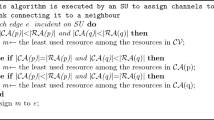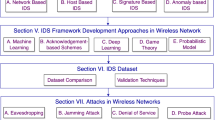Abstract
This paper presents different relay and jammer selection schemes for one-way cooperative networks to increase the security against malicious eavesdroppers. We consider a single source-destination cooperative network with multiple intermediate nodes and one or more eavesdroppers. The selection in the proposed schemes is made with the presence of direct links and the assumption that the broadcast phase is unsecured. The proposed schemes select three intermediate nodes. The first selected node operates in the conventional relay mode and assists the source to deliver its data to the corresponding destination via a Decode-and-Forward strategy. The second and third selected nodes are used in different communication phases as jammers to create intentional interference at the eavesdroppers’ nodes. Moreover, a hybrid scheme which switches between jamming and non-jamming modes is introduced in this paper. The proposed schemes are analyzed in terms of ergodic secrecy capacity and secrecy outage probability. Extensive analysis and a set of simulation results are presented to demonstrate the effectiveness of the different schemes presented in this work. The obtained results show that the proposed schemes with jamming outperform the conventional non-jamming schemes and the hybrid switching scheme further improves the secrecy capacity. The impact of changing both the eavesdroppers and the relays location on ergodic secrecy capacity and secrecy outage probability is also discussed. Finally, the impact of the presence of multiple eavesdroppers is studied in this paper.















Similar content being viewed by others
References
Silva, E. D., Santos, A. L. D., Albini, L. C. P., & Lima, M. (2008). Identity-based key management in mobile ad hoc networks: Schemes and applications. IEEE Wireless Communications, 15, 46–52.
Wyner, A. D. (1975). The wire-tap channel. Bell System Technical Journal, 54, 1355–1387.
Csiszar, I., & Korner, J. (1978). Broadcast channels with confidential messages. IEEE Transactions on Information Theory, 24, 451–456.
Liu, R., Maric, I., Spasojevic, P., & Yates, R. D. (2008). Discrete memoryless interference and broadcast channels with confidential messages: Secrecy rate regions. IEEE Transactions on Information Theory, 54, 2493–2507.
Bloch, M., Barros, J., Rodrigues, M. R. D., & McLaughlin, S. W. (2008). Wireless information-theoretic security. IEEE Transactions on Information Theory, 54, 2515–2534.
Barros, J., & Rodrigues, M. R. D. (2006, July) Secrecy capacity of wireless channels. In Proceedings of IEEE international symposium on information theory (pp. 356–360). Seattle, USA.
Liang, Y., Poor, H. V., & Ying, L. (2008, February) Wireless broadcast networks: Reliability, security, and stability. In Proceedings of the 3rd workshop on information theory and applications (pp. 249–255). San Diego, CA, USA.
Dong, L., Han, Z., Petropulu, A. P., & Poor, H. V. (2008, September). Secure wireless communications via cooperation. In Proceedings of Allerton conference on communication, control and computing, Urbana-Champaign, IL, USA.
Laneman, J. N., Tse, D. N. C., & Wornell, G. W. (2004). Cooperative diversity in wireless networks: Efficient protocols and outage behavior. IEEE Transactions on Information Theory, 50, 3062–3080.
Bletsas, A., Shin, H., & Win, M. Z. (2007). Cooperative communications with outage-optimal opportunistic relaying. IEEE Transactions on Wireless Communications, 6, 3450–3460.
Yang, S., & Belfiore, J.-C. (2007). Towards the optimal amplify-and-forward cooperative diversity scheme. IEEE Transactions on Information Theory, 53, 3114–3126.
Dong, L., Han, Z., Petropulu, A., & Poor, H. V. (2010). Improving wireless physical layer security via cooperating relays. IEEE Transaction on Signal Processing, 58, 1875–1888.
Lai, L., & El Gamal, H. (2008). The relay-eavesdropper channel: Cooperation for secrecy. IEEE Transactions on Information Theory, 54, 4005–4019.
Krikidis, I. (2010). Opportunistic relay selection for cooperative networks with secrecy constraints. IET Communications, 4, 1787–1791.
Krikidis, I. (2009). Relay selection for secure cooperative networks with jamming. IEEE Transactions on Wireless Communications, 8, 5003–5011.
Beres, E., & Adve, R. (2008). Selection cooperation in multi-source cooperative networks. IEEE Transactions on Wireless Communications, 7, 118–127.
Ibrahim, A. S., Sadek, A. K., Su, W., & Liu, K. J. (2008). Cooperative communications with relay selection: When to cooperate and whom to cooperate with. IEEE Transactions on Wireless Communication, 7, 2814–2827.
Simeone, O., & Popovski, P. (2008). Secure communications via cooperating base stations. IEEE Communications Letters, 12, 188–190.
Popovski, P., & Simeone, O. (2009). Wireless secrecy in cellular systems with infrastructure-aided cooperation. IEEE Transactions on Information Forensics and Security, 4, 242–256.
Tekin, E., & Yener, A. (2008). The general Gaussian multiple access and two-way wire-tap channels: Achievable rates and cooperative jamming. IEEE Transactions on Information Theory, 54, 2735–2751.
Wang, T., & Giannakis, G. B. (2008). Mutual information jammer-relay games. IEEE Transactions on Information Forensics and Security, 3, 290–303.
Hassan, E. S. (2012). Energy-efficient hybrid opportunistic cooperative protocol for single-carrier frequency division multiple access-based networks. IET Communications, 6(16), 2602–2612.
Al-nahari, A. Y., Krikidis, I., Ibrahim, A. S., Dessouky, M. I., Abd El-Samie, F. E. (2012, November) Relaying techniques for enhancing the physical layer secrecy in cooperative networks with multiple eavesdroppers. Transactions on Emerging Telecommunications Technologies. doi:10.1002/ett.2581.
Author information
Authors and Affiliations
Corresponding author
Rights and permissions
About this article
Cite this article
Ibrahim, D.H., Hassan, E.S. & El-Dolil, S.A. A New Relay and Jammer Selection Schemes for Secure One-Way Cooperative Networks. Wireless Pers Commun 75, 665–685 (2014). https://doi.org/10.1007/s11277-013-1384-5
Published:
Issue Date:
DOI: https://doi.org/10.1007/s11277-013-1384-5




